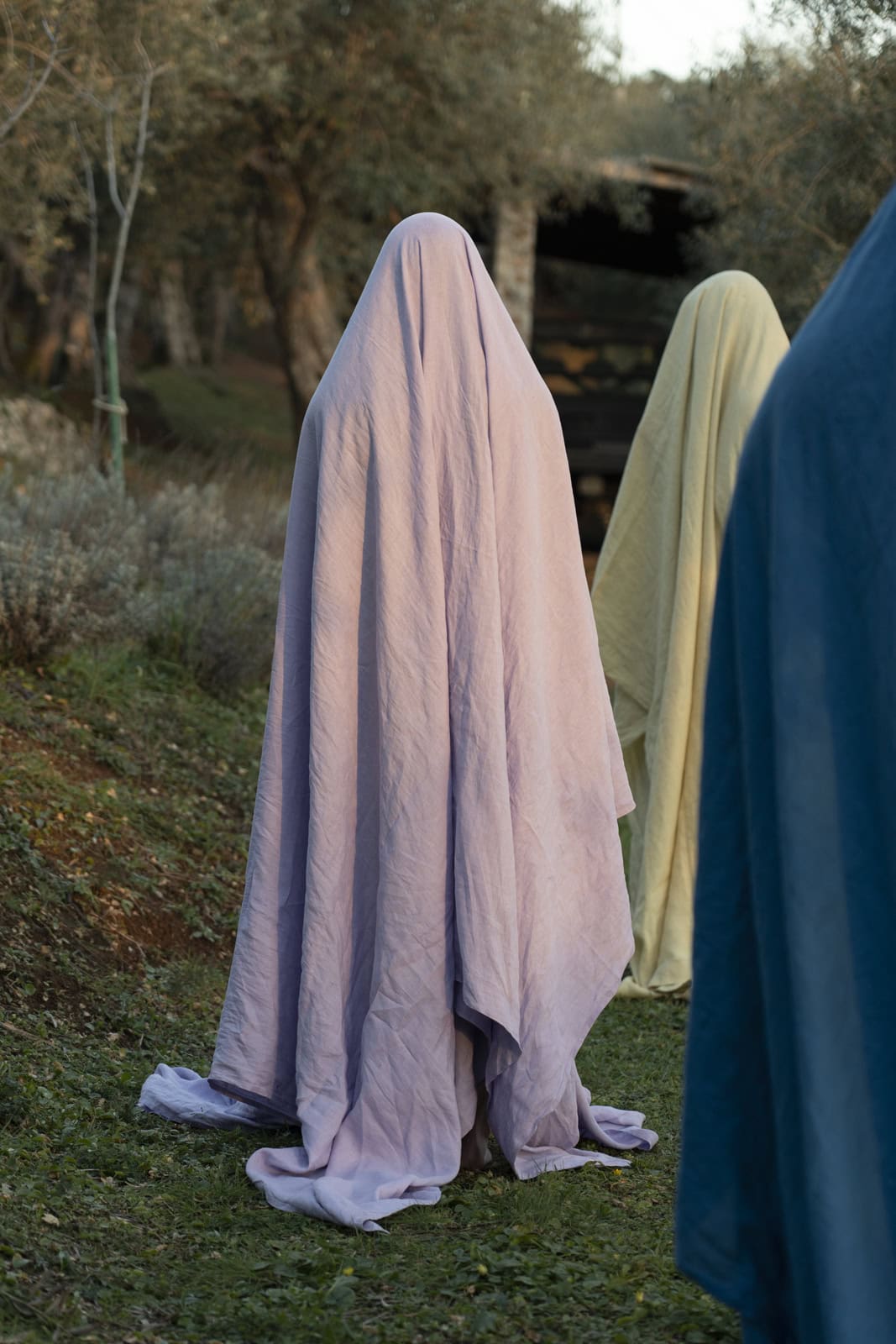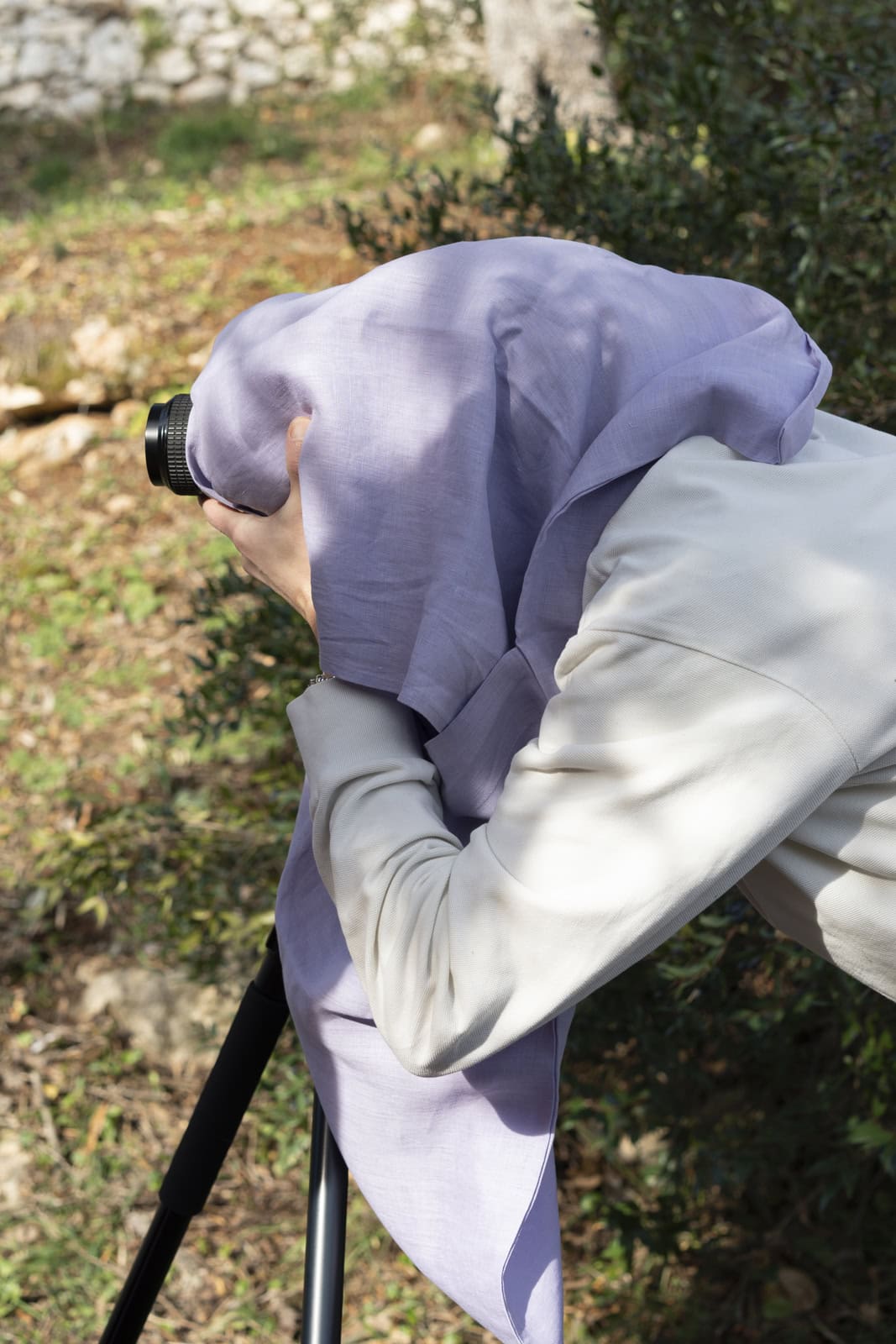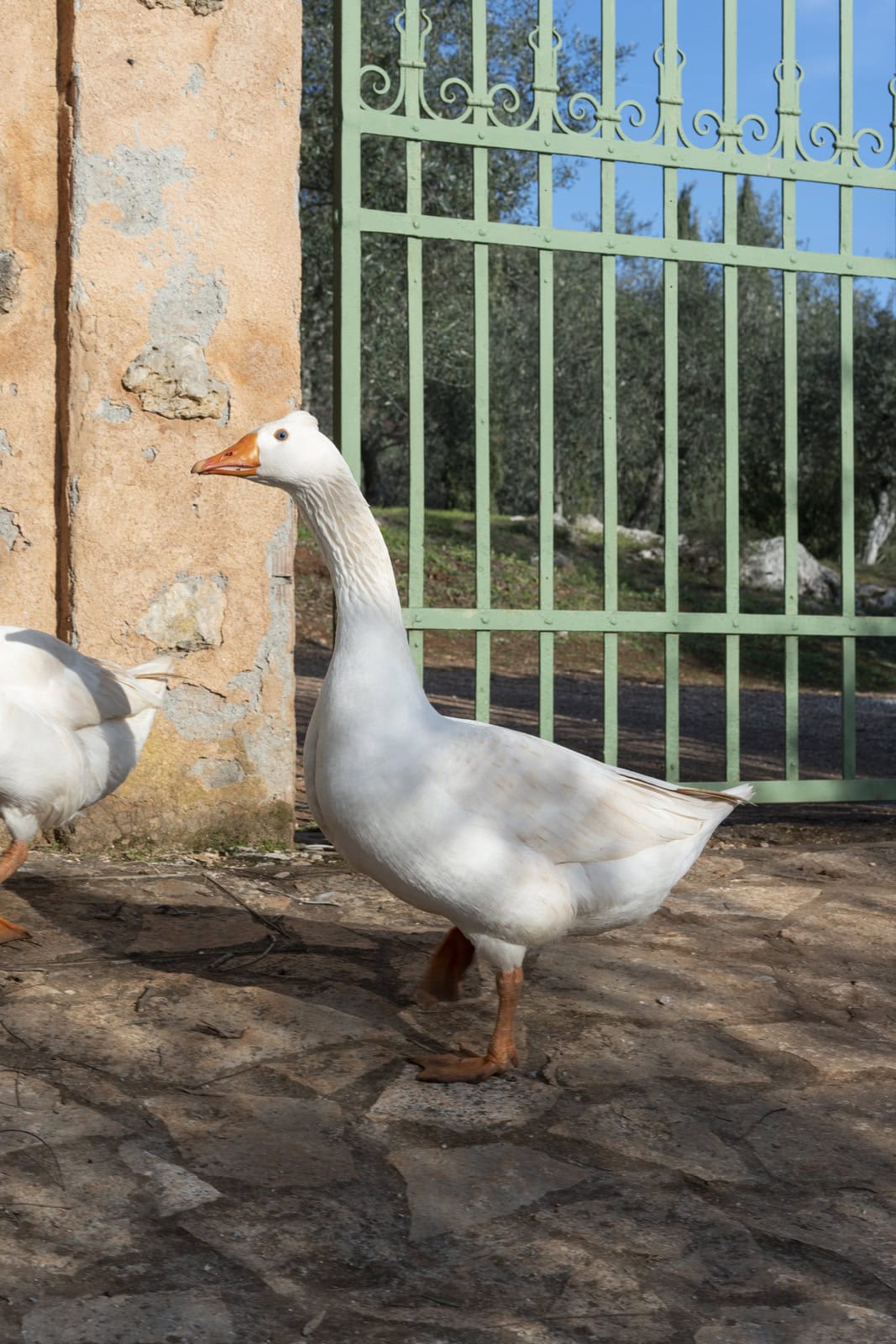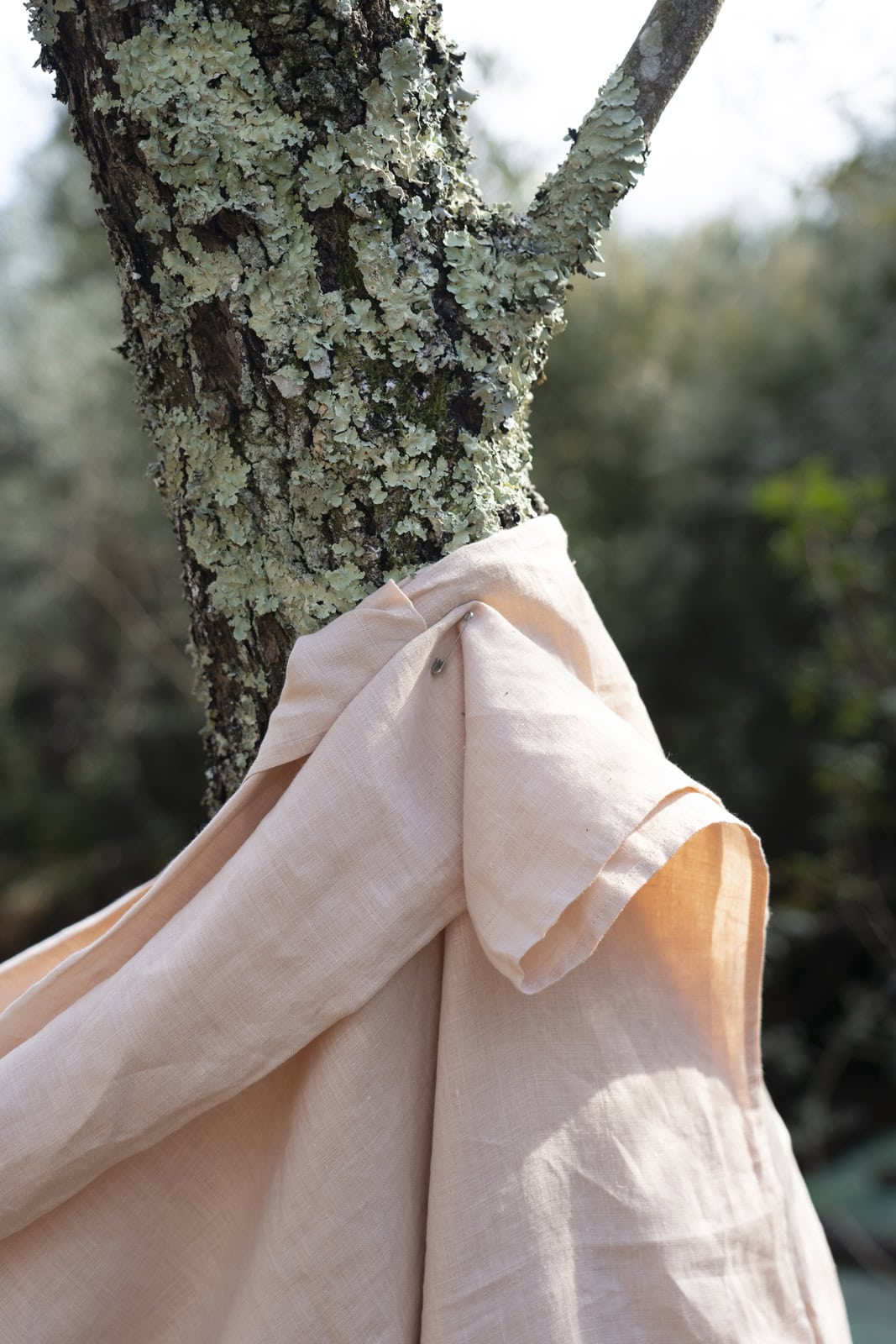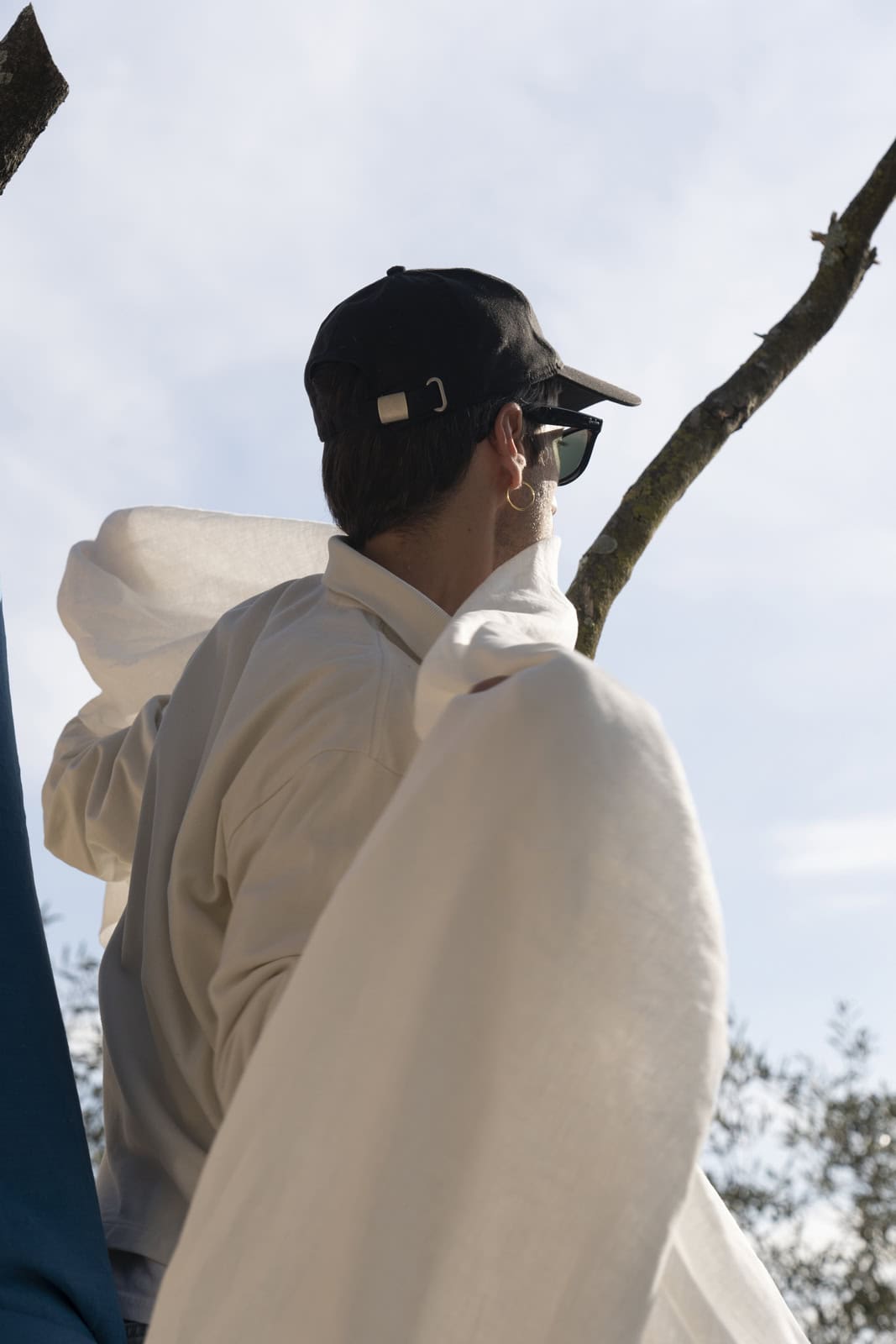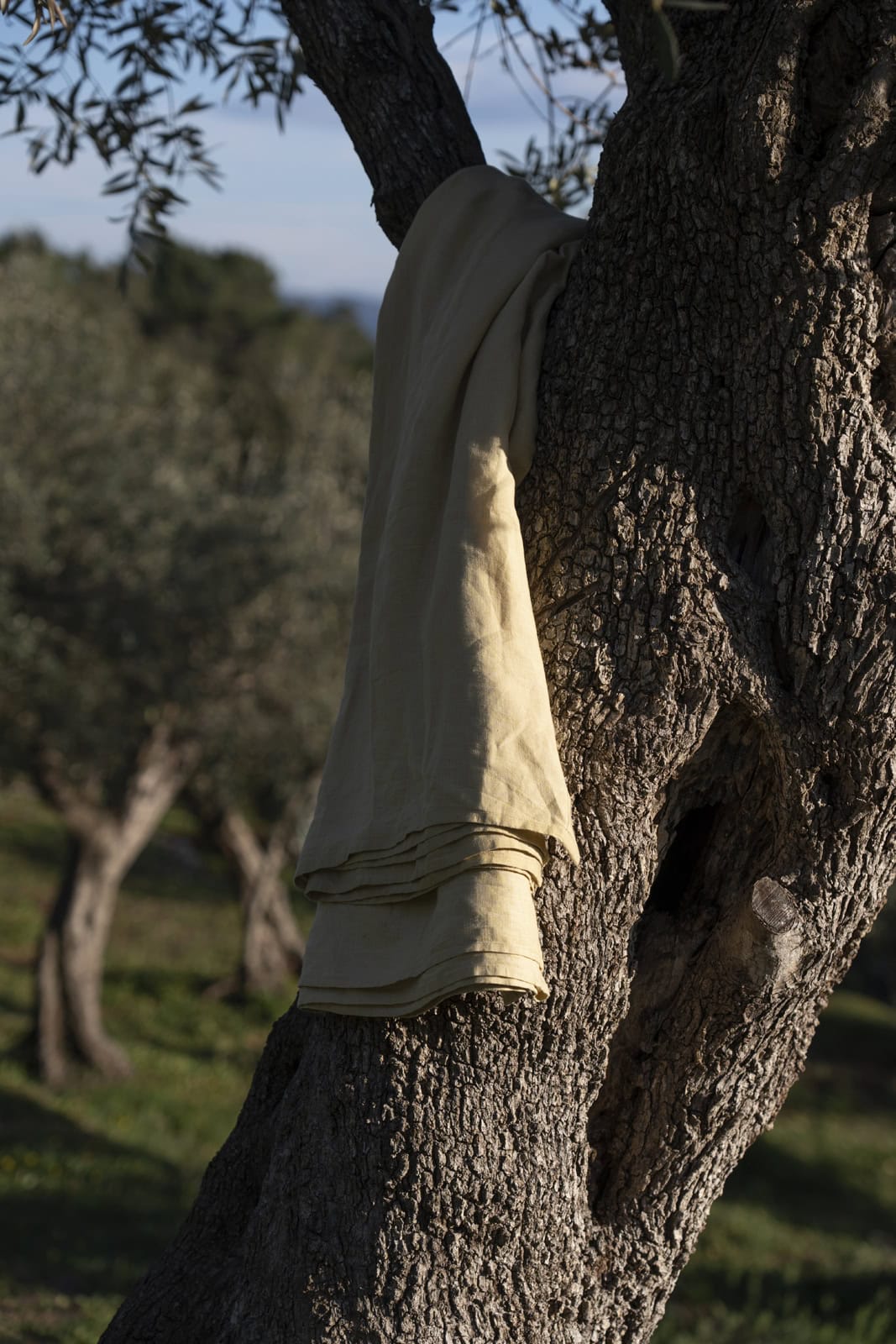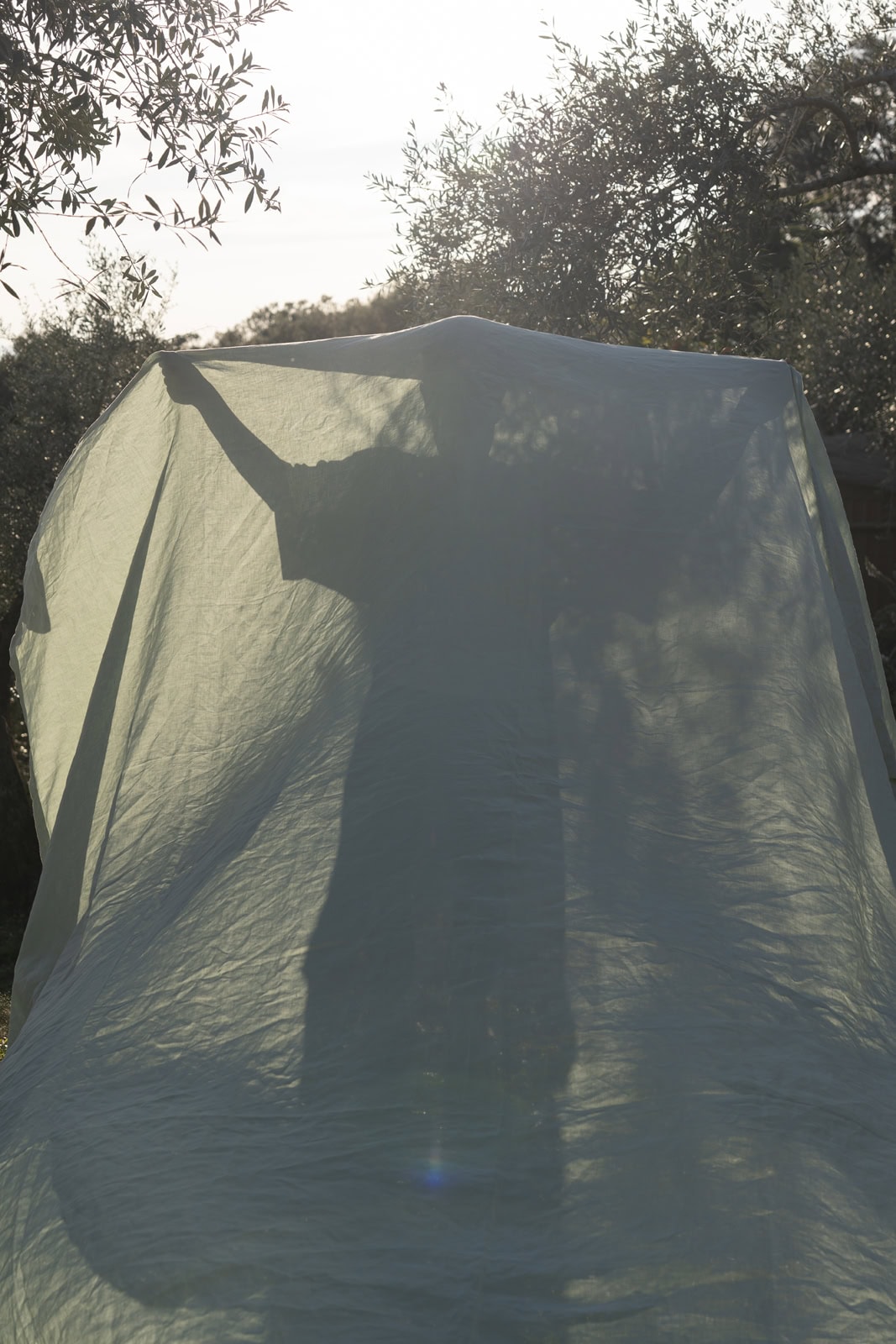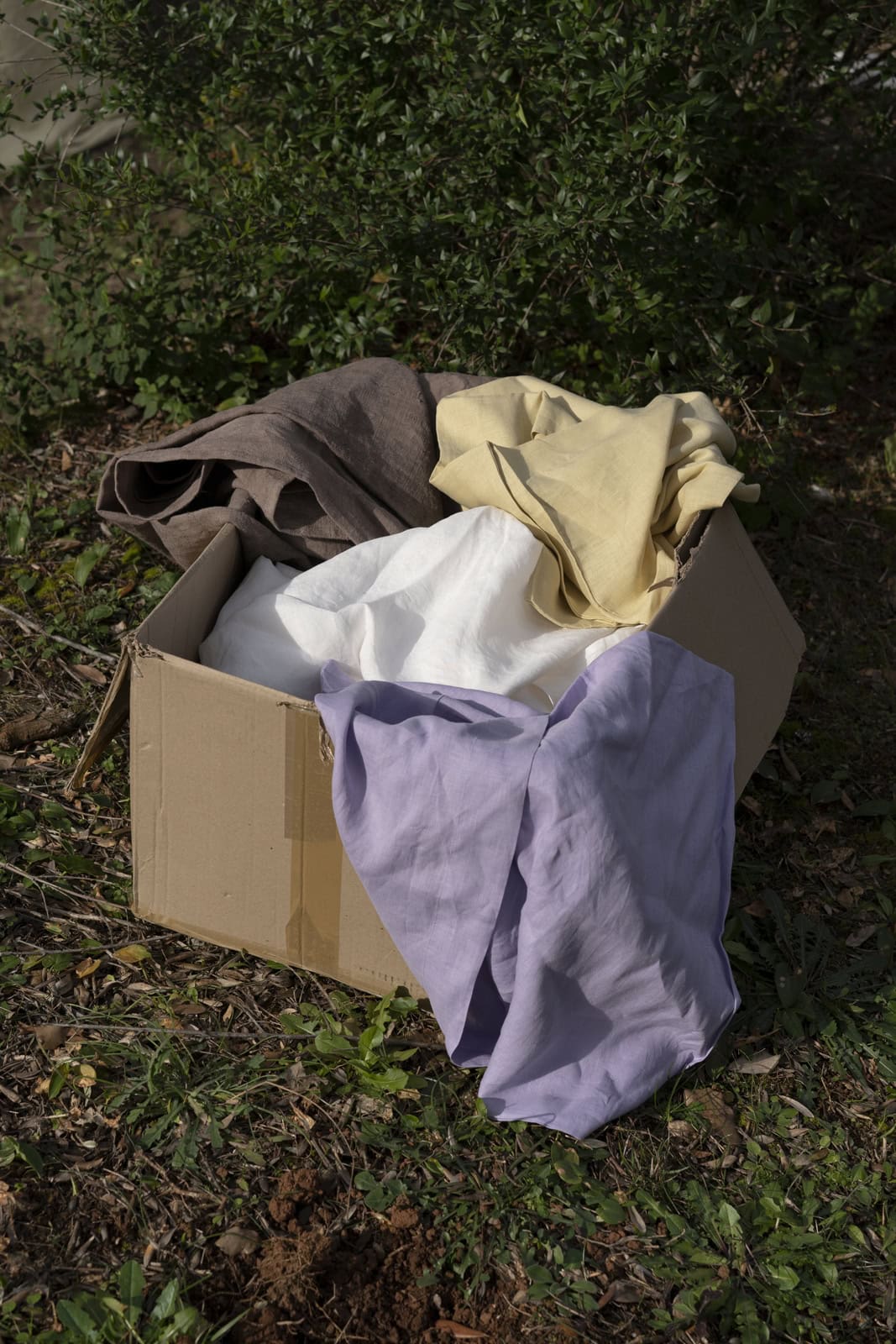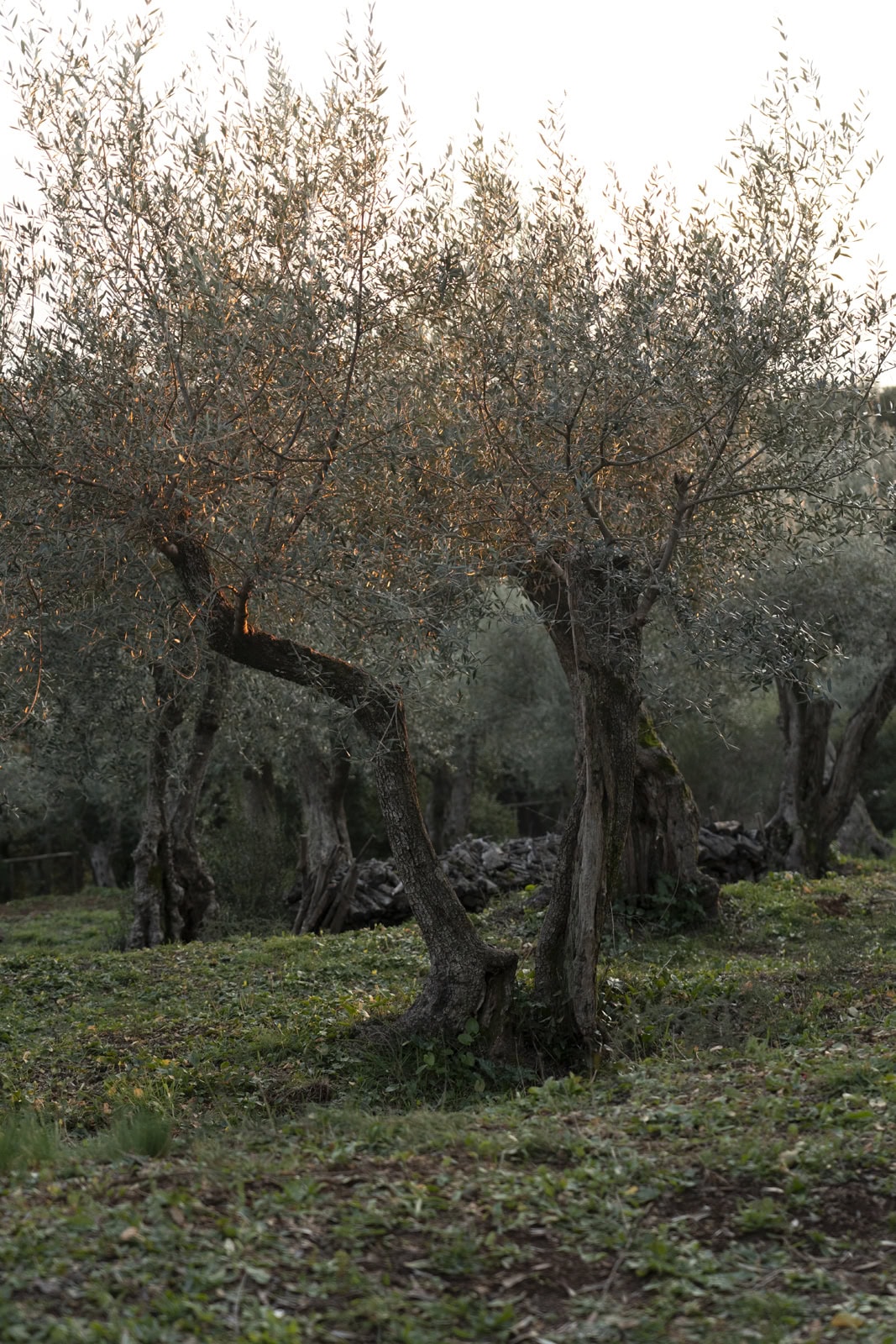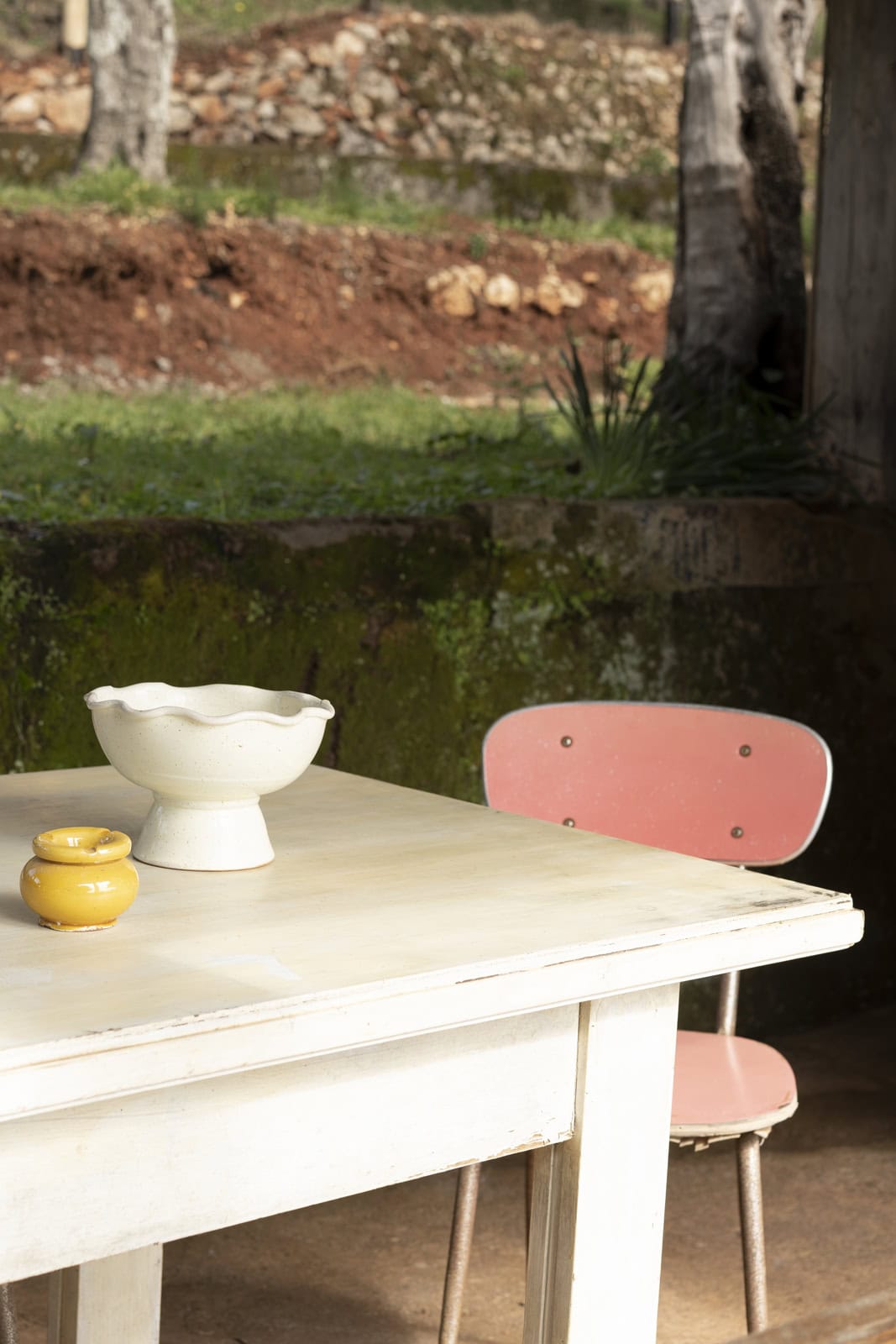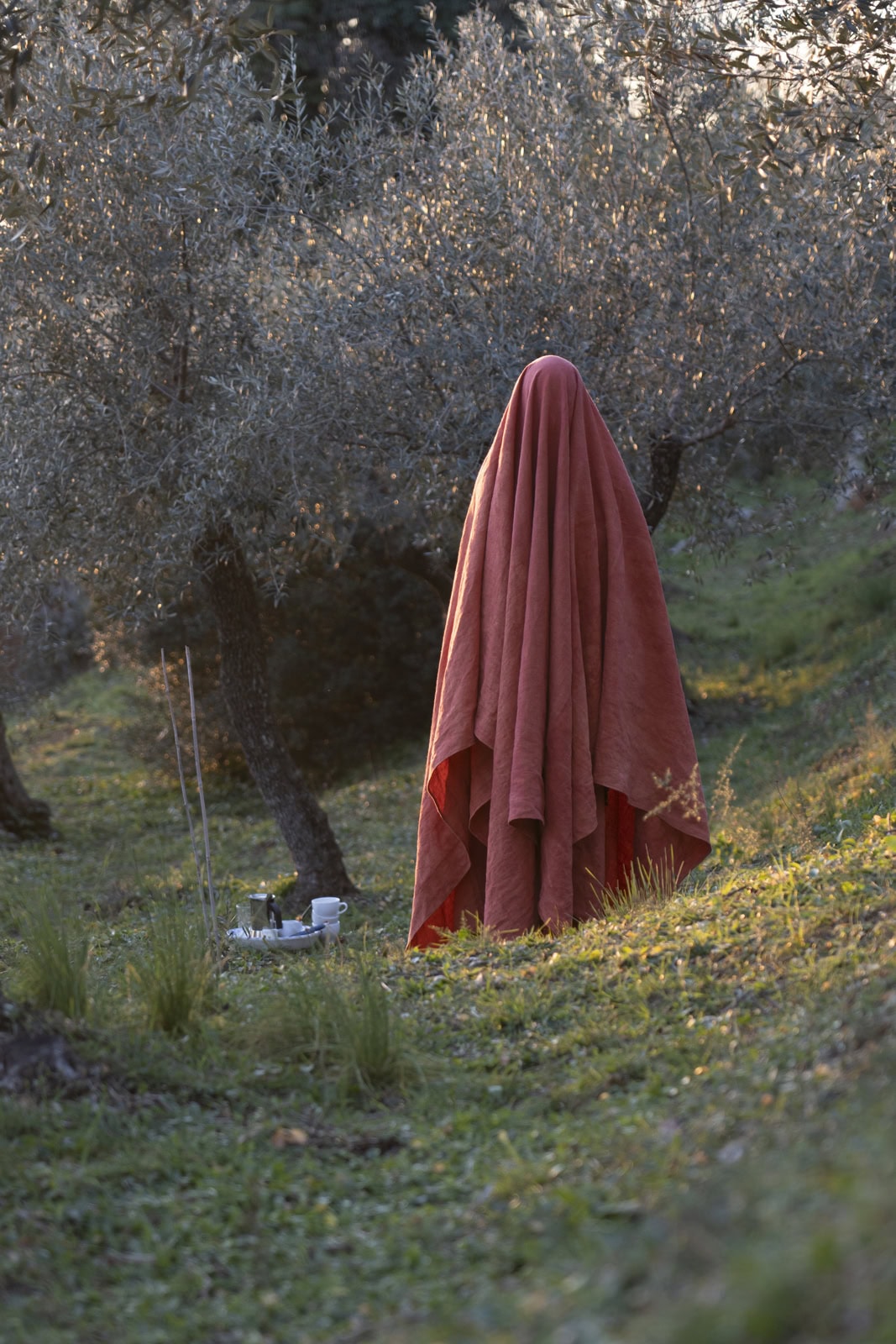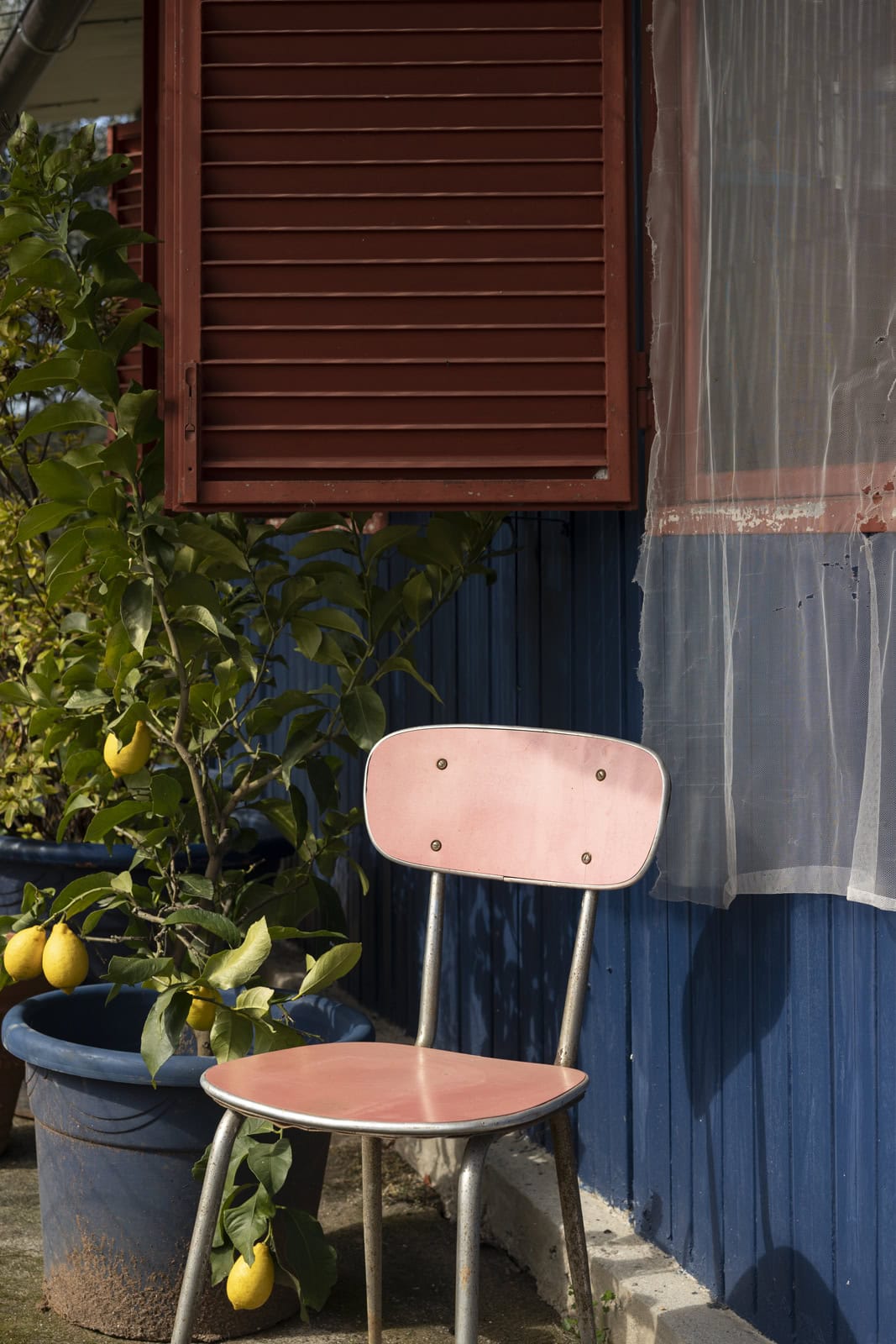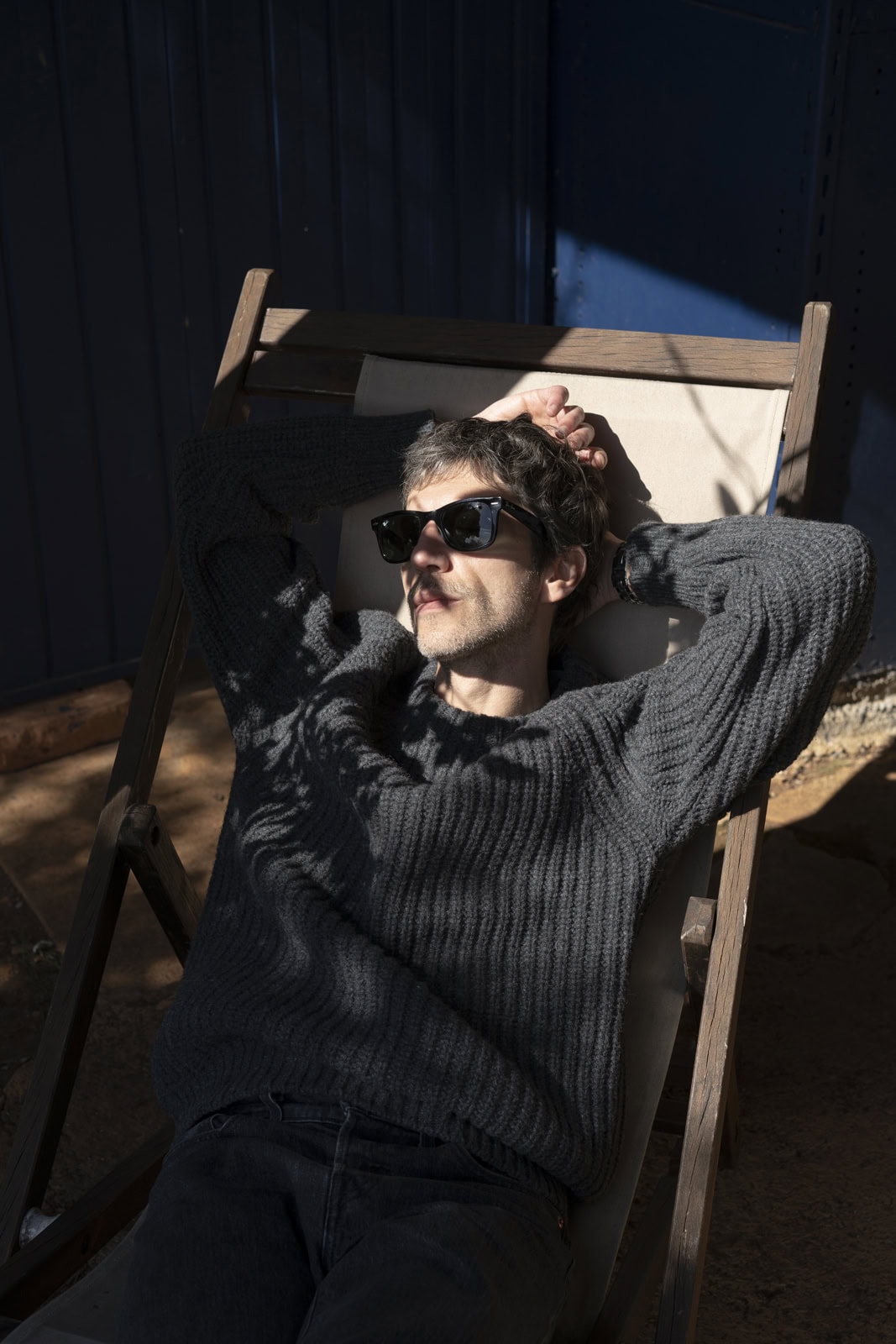Iacopo Pasqui is one of those photographers capable of capturing what is there even when it cannot be seen. Watching him work, one understands that before the photograph, there’s always a precise vision of the world. When I meet him, he is hiding portions of trees under coloured bed sheets. Only later will I discover that soon it will be our turn to become trees.
Running barefoot in the wet grass covered in forgotten hues is a particularly precise way of becoming children again. Iacopo knows this and watches us stumble—forgetting about the cold and the shame. He covers us to let us bloom silently, sheltered from the indiscreet frenzy of the city.
From our small natural fibre greenhouse, we catch a glimpse of the sunset caressing La Stellata before turning towards the sea. “The horizon serves to cleanse the gaze,” Iacopo tells me, as he searches for it every evening. I don’t live by the sea and often wonder which direction I should look at. Often, but not then.
Iacopo Pasqui’s stay at La Stellata lasted about a week. During those days, Iacopo engaged in a dialogue between the bed sheets of Casa Parini and nature, as if nothing had ever separated them. The result is a series of images that embrace each other, as suggested by the title taken from an iconic song by Lucio Battisti: Abbracciala, Abbraciali, Abbraciati (Embrace Her, Embrace Them, Embrace Each Other). The exhibition will be inaugurated on May 20th at LABottega and will be open for visitation until August 20th.
But before we could glimpse its direction, Iacopo and I took advantage of a darker cloud to pause for a moment and translate those ghostly sensations into words.
“Cosa ti dicevo mai? A che punto ero? Ho quasi l’impressione che io con te perdo il sentiero.”
(What was I telling you? Where was I? I almost have the impression that I lose my path with you)
RSS: What were your first impressions when you arrived?
IP: It was all dark, so I didn’t immediately realize what was around me. But I quickly understood that it was a complex place and, at the same time, necessary. I needed to spend a few days in isolation, especially in a context like this. Despite the solitude and absence of people, this place has powerful and undeniably positive energies.
RSS: How has your perspective changed over the days? And your perception of the place?
IP: It has undoubtedly adapted and changed the perception because it’s a very “charged” place. There is a lot of vegetation, and it’s difficult to find reference points. It took me a while to get used to this complexity, to all these layers. Over the days, I’ve somewhat tamed it with my gaze.
RSS: What does this place symbolically communicate to you? What meaning does the time you’re spending here have?
IP: First and foremost, it’s a challenge. The bed sheets are almost immaterial objects: photographing them is like photographing coloured air. Complex but creatively stimulating.
RSS: What is your favourite time of day here?
IP: There are two: early morning because a beautiful light begins to emerge, which changes a lot throughout the day, and evening, right after sunset—the moment when everything fades away, and energies discharge. It’s a magical moment, especially when you look at the sea and nature becomes silent.
RSS: Are you a diurnal or nocturnal creature?
IP: Diurnal: as a photographer, I prefer the day, the revealing light. The night is meant for dreaming, although I sleep very little.
RSS: Going back to your exploration here. What journey have you undertaken since you arrived? What were you searching for?
IP: I wondered about the elements that characterize these bed sheets: the natural fibre fabric, the colour, but also their function. A bed sheet serves to cover and accompanies rest. Still, it also relates to many other aspects of human life: it hosts dreams, listens to discussions, and witnesses feelings, love, and arguments…
RSS: I was just about to ask you: What is a bed sheet to you, beyond being a bed sheet?
IP: A bed sheet can be many things. It can be passion and romance but also detachment and isolation. It can have many contradictory meanings, but in all cases, it envelops. And being a natural fibre bed sheet, I liked the idea of returning it to nature. Starting from its material essence, I decided to give it organic forms and cover the surrounding nature. From there, the bedsheet that wraps around a prickly pear, an olive tree trunk, a tree… I wanted to give shape to this immaterial and light element like air and let it rest on nature—to bring it back to its origins. At the same time, I liked the idea of returning the bed sheet to the realm of play, which is one of the first things we engage with. I immediately thought of ghosts. As children, we mainly used white bed sheets; in this case, they are all very colourful. That’s why I decided to involve more people—more extras—and have each one interpret a different ghost. I wanted them to immerse themselves in nature and become one with it. Subsequently, with their colours, these ghosts made me think of souls that merge into one. The main photograph, which I believe summarizes the entire project, is that of the ghosts—souls—embracing each other. I see everything I have worked on here within it, and I associate it a lot with the soundtrack that accompanied me on this journey and inspired the work.
RSS: What does the music you selected talk about? What worlds does it evoke?
IP: It evokes an emotionally warm, bucolic, natural, enveloping world, but also full of contrasts. A world that returns to its origins, therefore also a bit wild and untamed.
RSS: Your work here seems to revolve around a form of regression, but in a positive sense. There’s the bedsheet returning to nature, adults becoming ghosts and returning to childhood…
IP: Exactly. The idea is that, for those final photographs, the bedsheets have to go through various forms, which then materialize with human but almost spiritual presence. We know that there are people under the bedsheets, but they could also be forces that nature somehow moves and attracts.
RSS: Do you think the previous shots helped you reach this point? Or do they all participate in mapping your experience here?
IP: Both, because the shots work sequentially. They are functional in reaching a final image, but that only works in relation to the preceding ones. Everything is interconnected.
RSS: How does this work fit into your journey as an artist and photographer?
IP: It fits into a particular moment because I’m currently not working on new research projects but mainly on exhibition projects.
RSS: But are there recurring themes? Maybe nature?
IP: Yes, but marginal nature. Usually, it’s there, but it’s a context. In this case, however, it is the protagonist.
RSS: Nature is an unpredictable subject. How do you relate to the unexpected? The light, the weather… But also life’s occurrences.
IP: Initially, not very well. But then, slowly, you learn to manage it, to use it to your advantage. There may be no light, and you have to find a way to create it or do without it. Or the light comes and goes, and the framing doesn’t work… Personally, I try to find a solution that can turn the unexpected into an advantage. I don’t always succeed—luck plays a role. Sometimes it’s torture because you have an idea in your head, you’ve already visualized the photograph you’re looking for, and yet you can’t find it. So, the unexpected is undoubtedly challenging but can also be beautiful. If everything were easy, there would be no taste for the challenge.
RSS: Definitely. Observing you, one can see this conflict as an integral part of the process. What is your relationship with photography? Do you see it more as a tool to understand yourself or the reality around you?
IP: For me, photography is almost a tool for self-analysis. It has helped me a lot to know myself in relation to what is outside of me, both in a natural and emotional sense. Through self-knowledge, it has allowed me to relate to the external world. But it has also been a tool for protection.
RSS: I wanted to ask you about that. Being a filter, it can both help you get closer and distance yourself from your subject.
IP: Exactly. I realize it might seem a bit sad because, in the end, you look at everything through a glass—which protects your eye and therefore yourself. Many times I have photographed what I felt I couldn’t have, what didn’t belong to me. Other times, what scared me but also fascinated me—what I couldn’t relate to. In those cases, photography becomes a powerful filter because it allows you to get closer without exposing yourself. It becomes a barrier between you and things. For me, photography is also a tool to escape from reality, allowing me to construct my version of what surrounds me. In this way, I understand what is truly important.
